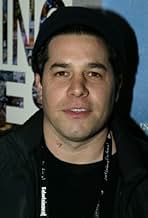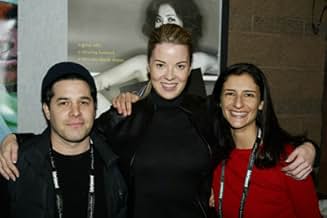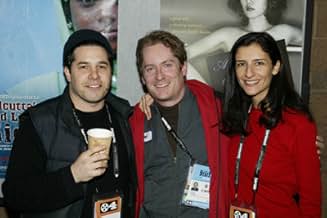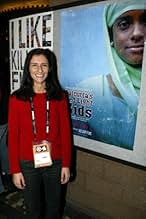Im Bordell geboren - Die Kinder im Rotlichtviertel von Kalkutta
Originaltitel: Born Into Brothels: Calcutta's Red Light Kids
IMDb-BEWERTUNG
7,2/10
18.426
IHRE BEWERTUNG
Zwei Dokumentarfilmer berichten über ihre Zeit in Sonagchi, Kalkutta, und die Beziehungen, die sie zu Kindern von Prostituierten entwickelten, die im berüchtigten Rotlichtviertel der Stadt a... Alles lesenZwei Dokumentarfilmer berichten über ihre Zeit in Sonagchi, Kalkutta, und die Beziehungen, die sie zu Kindern von Prostituierten entwickelten, die im berüchtigten Rotlichtviertel der Stadt arbeiten.Zwei Dokumentarfilmer berichten über ihre Zeit in Sonagchi, Kalkutta, und die Beziehungen, die sie zu Kindern von Prostituierten entwickelten, die im berüchtigten Rotlichtviertel der Stadt arbeiten.
- Regie
- Drehbuch
- Hauptbesetzung
- 1 Oscar gewonnen
- 21 Gewinne & 5 Nominierungen insgesamt
Zana Briski
- Self "Zana Auntie"
- (Nicht genannt)
Sunil Halder
- Self
- (Nicht genannt)
- …
Empfohlene Bewertungen
A great documentary, which reveals a sad Indian reality, it makes us think about human rights, especially children. The documentary carries shocking phrases especially because they are spoken by children. At last a great movie even being a sad story.
I often disagree with the academy award nominations. It's usually too political to nominate the best movies and performances of the year. Born Into Brothels is an exception, it was nominated and won! The only mistake was not nominating it for best picture.
Brothels is the story of a woman, Zana Briski, who traveled to Calcutta to photograph the brothels. She fell in love with the children and began teaching them photography. The movie is seen through their eyes.
The result is extraordinary in so many ways. Calcutta's red light district is interesting in and of itself. The setting is the first extraordinary feature. The filming makes you feel like you are there. Director Ross Kauffman captures the feeling of being trapped in dark allies with a dark future. Without a director commentary running though the film, you're able to see it all by the way it's been directed. The dark past and future of these families is presented in a beautiful and horrific way.
Secondly, the children are lovable. The story focuses on 8 or 9 children of prostitutes. Each one is unique. Some are incredibly funny, others serious, some are troubled, and at least one has an undeniable talent for photography. You'll leave the theater feeling like you know them.
This is documentary film at its best. It transports us to another country and makes us love the troubled children. What was troubling to me was having to leave the theater never to see these troubled children again. Putting aside the incredible movie-making abilities of these creators, Zana Briski is a true hero.
Brothels is the story of a woman, Zana Briski, who traveled to Calcutta to photograph the brothels. She fell in love with the children and began teaching them photography. The movie is seen through their eyes.
The result is extraordinary in so many ways. Calcutta's red light district is interesting in and of itself. The setting is the first extraordinary feature. The filming makes you feel like you are there. Director Ross Kauffman captures the feeling of being trapped in dark allies with a dark future. Without a director commentary running though the film, you're able to see it all by the way it's been directed. The dark past and future of these families is presented in a beautiful and horrific way.
Secondly, the children are lovable. The story focuses on 8 or 9 children of prostitutes. Each one is unique. Some are incredibly funny, others serious, some are troubled, and at least one has an undeniable talent for photography. You'll leave the theater feeling like you know them.
This is documentary film at its best. It transports us to another country and makes us love the troubled children. What was troubling to me was having to leave the theater never to see these troubled children again. Putting aside the incredible movie-making abilities of these creators, Zana Briski is a true hero.
The film makers of this documentary take the viewer into areas that would have been off limits to anyone wanting to explore the life of the children of some Calcutta prostitutes. About ten children are showcased in the film as one of the directors of the documentary, Zana Briski, involves the children in something positive as she teaches them how to use the camera in capturing the world around them.
In gaining the children's confidence, they, in turn, tell us about how they see life in that hostile environment. Most of the girls shown in the film would probably end up in the same situation their mothers went through, as it appears life for them is a vicious circle in which there is no escape. For the boys, in spite of the natural talent shown as they take pictures, the mean streets of Calcutta don't promise much either.
As a documentary, Ms. Briski and Mr. Kauffman, show us how they were able to give the children a different way to look at life, but one wonders what has happened after they finished their work. Are these young girls and boys better off because this experience, or did they go back to the only way of life they knew about?
"Born into Brothels" is a sad commentary on our society at large, because where there is poverty, as it's the case in Calcutta, women will resort into the kind of life where they can get by without any education or skills. These women are actually the victims of a system that penalizes them for just being in the wrong place, at the wrong time.
Let's hope Ms. Briski and Mr. Kaufamn were able to instill in these young girls and boys the idea of looking for something better in their lives if they escape the poor surroundings in which they were born into.
In gaining the children's confidence, they, in turn, tell us about how they see life in that hostile environment. Most of the girls shown in the film would probably end up in the same situation their mothers went through, as it appears life for them is a vicious circle in which there is no escape. For the boys, in spite of the natural talent shown as they take pictures, the mean streets of Calcutta don't promise much either.
As a documentary, Ms. Briski and Mr. Kauffman, show us how they were able to give the children a different way to look at life, but one wonders what has happened after they finished their work. Are these young girls and boys better off because this experience, or did they go back to the only way of life they knew about?
"Born into Brothels" is a sad commentary on our society at large, because where there is poverty, as it's the case in Calcutta, women will resort into the kind of life where they can get by without any education or skills. These women are actually the victims of a system that penalizes them for just being in the wrong place, at the wrong time.
Let's hope Ms. Briski and Mr. Kaufamn were able to instill in these young girls and boys the idea of looking for something better in their lives if they escape the poor surroundings in which they were born into.
It would certainly take a filmmaker of much self-consciousness, something which Zana Briski certainly possesses, to make this film the way she has. Having met with uncooperative roadblocks to shooting a documentary about sex-workers and their families within the squalid confines of Calcutta's red-light district, Briski states early on that she decides to have the children themselves tell their story by supplying them with automatic cameras to use in their own personal ways. The film, however, ultimately becomes an account of one outsider's attempt to save these children from their miserable fates - poverty and sexual abuse. With the children's sex-worker mothers and families, many of whom have apparently spent generations in the district with no escape in sight, used as background elements, Briski focuses solely on the children, entering them into an informal photography seminar where they gather to share contact sheets of their pictures and discuss the problems of shooting amidst uncooperative and hostile subjects and why certain pictures work and why some don't. Thankfully, Briski also interviews the children, and while it's not clear they understand her theories on picture composition, they are, despite being denied education and living amidst fairly brutal conditions of abuse, poverty and indentured servitude, very perceptive and wise to the unfortunate conditions in which they live, their prospects and possess an awareness of the possibilities of life outside of the district. Briski becomes further involved with the children by trying to enter them into school, though most will not accept them because they are the children of sex workers. Indeed, it is the indifference of Indian authorities to the children's plight as much as the abuse they receive from their depraved parents that shocks the viewer. Briski, with some help from some photographic arts people in the United States and Amnesty International, is able to use the children's pictures as a commercial vehicle to raise money to enable them to enroll in a private boarding school (the kids are well aware that education is their only way out of the brothels). Here, Briski's movement somewhat takes over the movie from her subjects, proving how futile western notions of compassionate aid often are to endemic and grave third-world situations like we witness here. This is driven home when of the kids accepted into the boarding school, only one eventually remains because of the economic pressures put upon their families in which the children essentially act as indentured servants, performing household tasks day and night and odd jobs for additional income. So, while the film becomes a parade for Briski's noble cause, I would have liked to have seen more background and interaction between the children and their surroundings, other than simply as child photographers who have been given a brief and, for most of them, fleeting reprieve from their depraved surroundings.
This film should be seen by everyone who has any sense of what the world is and can be if we give our attention and empathy to make it a better place --in the background I hear the greed and anger of Donald Trump and it is so jarring (and sad) and disturbing ....it is absolutely amazing the dedication and caring of Zana Briski an Ross Kauffman and their attempt to support and change the destinies of these poor unfortunate children who are doomed to a life of humiliation, poverty and human degradation. It is uplifting to know that there are people who care --who are not driven by greed and avarice-- who will try , no matter what the odds are, no matter what are the bureaucratic difficulties to help and support these poor unfortunate children .. I know that I have been immensely moved by this film and what is going on in a place like the red light district of Calcutta and will do what I can to make some impact with these unfortunate children in all of the various venues that these people have chosen to work in and do these miraculous things that are they are doing.
Wusstest du schon
- SoundtracksSankarabaranam pancha nadai pallavi
Performed by Shenkar and The Epidemics
Top-Auswahl
Melde dich zum Bewerten an und greife auf die Watchlist für personalisierte Empfehlungen zu.
Details
- Erscheinungsdatum
- Herkunftsland
- Offizieller Standort
- Sprachen
- Auch bekannt als
- Born Into Brothels: Calcutta's Red Light Kids
- Drehorte
- Produktionsfirmen
- Weitere beteiligte Unternehmen bei IMDbPro anzeigen
Box Office
- Bruttoertrag in den USA und Kanada
- 3.515.061 $
- Eröffnungswochenende in den USA und in Kanada
- 14.605 $
- 12. Dez. 2004
- Weltweiter Bruttoertrag
- 3.529.201 $
- Laufzeit1 Stunde 25 Minuten
- Farbe
- Sound-Mix
- Seitenverhältnis
- 1.37 : 1(original negative)
- 1.85 : 1
Zu dieser Seite beitragen
Bearbeitung vorschlagen oder fehlenden Inhalt hinzufügen

Oberste Lücke
What is the Spanish language plot outline for Im Bordell geboren - Die Kinder im Rotlichtviertel von Kalkutta (2004)?
Antwort




















